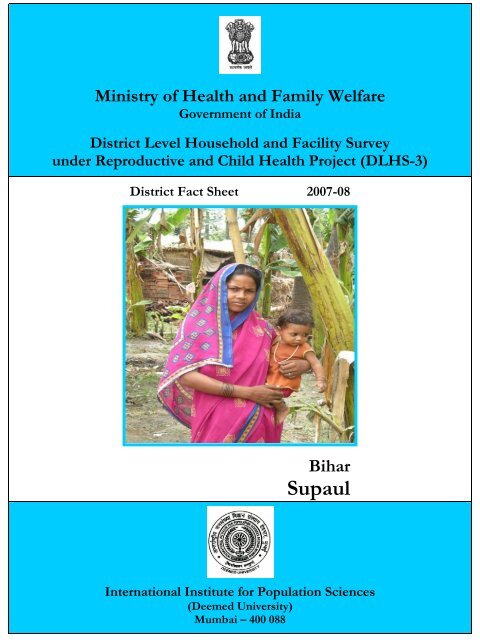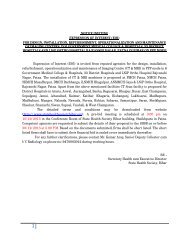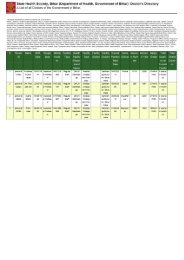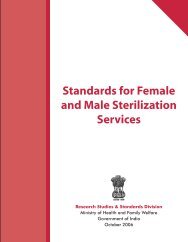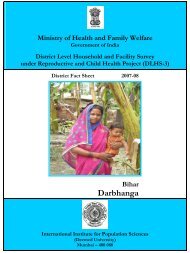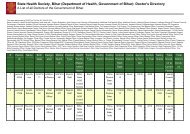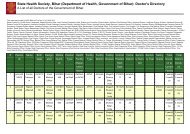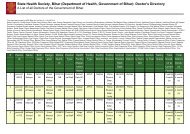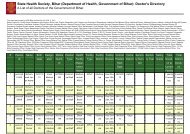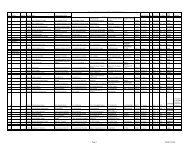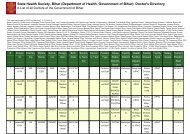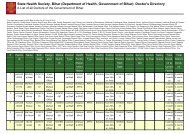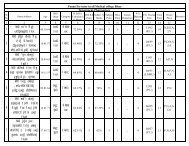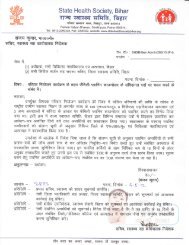Supaul - STATE HEALTH SOCIETY-----BIHAR
Supaul - STATE HEALTH SOCIETY-----BIHAR
Supaul - STATE HEALTH SOCIETY-----BIHAR
Create successful ePaper yourself
Turn your PDF publications into a flip-book with our unique Google optimized e-Paper software.
,<br />
Ministry of Health and Family Welfare<br />
Government of India<br />
District Level Household and Facility Survey<br />
under Reproductive and Child Health Project (DLHS-3)<br />
District Fact Sheet 2007-08<br />
Bihar<br />
<strong>Supaul</strong><br />
<<br />
International Institute for Population Sciences<br />
(Deemed University)<br />
Mumbai – 400 088
For further information, please contact:<br />
Additional Director General (Stat.)<br />
Ministry of Health and Family Welfare<br />
Government of India<br />
Nirman Bhavan<br />
New Delhi - 110 011<br />
Telephone: 011-23061334<br />
Fax: 011-23061334<br />
E-mail: adg-mohfw@nic.in<br />
Chief Director (Stat.)<br />
Ministry of Health and Family Welfare<br />
Government of India<br />
Nirman Bhavan<br />
New Delhi - 110 011<br />
Telephone: 011-23062699<br />
Fax: 011-23062699<br />
E-mail: cdstat@nic.in<br />
Director/ Project Coordinator (DLHS -3)<br />
International Institute for Population Sciences (IIPS)<br />
Govandi Station Road, Deonar<br />
Mumbai - 400 088<br />
Telephone: 022- 2556 3254/5/6<br />
Fax: 022- 2556 3257, 2555 5895<br />
E-mail: rchpro@iips.net, director@iips.net<br />
Website: http://www.rchiips.org
Bihar DLHS-3 District : <strong>Supaul</strong><br />
About DLHS - 3:<br />
The District Level Household Survey (DLHS) was initiated in 1997 with a view to assess the<br />
utilization of services provided by government health care facilities and people’s perception about<br />
the quality of services. The District Level Household Survey (DLHS -3) is the third in the series of<br />
district surveys, preceded by DLHS-1 in 1998-99 and DLHS-2 in 2002-04. As in DLHS-3, the<br />
International Institute for Population Sciences (IIPS) was the nodal agency to conduct DLHS-1 and<br />
DLHS-2. DLHS-3, like other two earlier rounds, is designed to provide estimates on important<br />
indicators on maternal and child health, family planning and other reproductive health services. In<br />
addition, DLHS-3 provides information on important interventions of National Rural Health<br />
Mission (NRHM). Unlike other two rounds in which only currently married women age 15-44 years<br />
were interviewed, DLHS -3 interviewed ever-married women (age 15-49) and never married women<br />
(age 15-24).<br />
The sample size among the districts in the country varies according to their performance in terms of<br />
Ante-Natal Care (ANC), institutional delivery, immunization, etc. and it was fixed based on<br />
information related to such indicators from DLHS-2. For low performing districts, 1500 Households<br />
(HHs), for medium performing districts, 1200 HHs and for good performing districts, 1000 HHs<br />
were fixed as sample size. In case of <strong>Supaul</strong>, sample size was 1500 households with 10% additional<br />
HHs to take care of non-response/refusal, etc.<br />
The survey used two-stage stratified random sampling in rural and three-stage stratified sampling in<br />
urban areas of each district. The information from 2001 Census was used as sampling frame for<br />
selecting primary sampling units (PSUs). In rural areas, all the villages in the district were stratified<br />
into different strata based on population /HH size, percentage of SC/ST population, female literacy<br />
(7+), etc. The required number of villages from each strata was selected with probability<br />
proportional to size (PPS). In selected primary sampling units (villages), household listing was done<br />
and required numbers of households were selected using systematic random sampling.<br />
For larger villages (more than 300 HHs) segmentation was carried out. In case of 300 to 600 HHs,<br />
two segments of equal size were made and one was selected using PPS. For PSUs having more than<br />
600 HHs, segments of 150 HHs were created depending on the size and then two segments were<br />
selected using PPS. In case of urban areas, number of wards were selected using PPS at first stage.<br />
In a selected ward, one enumeration block from 2001 census was selected again using PPS.<br />
Procedure for segmentation, household selection, etc, was same as in the case of rural PSUs.<br />
The uniform bilingual questionnaires, both in English and in local language, were used in DLHS-3<br />
viz., Household, Ever Married Women (age 15-49), Unmarried Women (age 15-24), Village and<br />
Health facility questionnaires.<br />
In the household questionnaire, information on all members of the household and the socioeconomic<br />
characteristics of the household, assets possessed, number of marriages to usual members<br />
of the household since January 2004 and deaths in the household since January 2004<br />
etc. was collected. In case of female deaths, attempts were made to assess maternal death. The<br />
household questionnaire also collected information on respondent’s knowledge (seen/read/ heard)<br />
about messages related to various government health programmes being spread through media and<br />
other sources.<br />
1
Bihar DLHS-3 District : <strong>Supaul</strong><br />
The ever married women's questionnaire consisted of sections on women's characteristics, maternal<br />
care, immunization and child care, contraception and fertility preferences, reproductive health<br />
including knowledge about HIV/AIDS.<br />
The unmarried women's questionnaire contained information on her characteristics, family life<br />
education and age at marriage, reproductive health-knowledge and awareness about contraception,<br />
HIV / AIDS, etc.<br />
The village questionnaire contained information on availability of health, education and other<br />
facilities in the village and whether the health facilities are accessible throughout the year.<br />
For the first time, population-linked facility survey has been conducted in DLHS-3. In a district, all<br />
Community Health Centres (CHCs) and District Hospital (DH) were covered. Further, all Subcentres<br />
(SC) and Primary Health Centres (PHC) which were expected to serve the population of the<br />
selected PSU were also covered. There were separate questionnaires for SC, PHC, CHC and DH.<br />
They broadly include questions on infrastructure, human resources, supply of drugs & instruments,<br />
and performance.<br />
Note:<br />
DLHS-2: information is based on data collected from currently married women 15-44 years.<br />
DLHS-3: information is based on data collected from ever married women 15-49 years.<br />
DLHS-2: In total percentage is adjusted for indicators considering over sampling of urban PSUs in<br />
DLHS-2. This adjustment is done in those districts where urban percentage is less than 30.<br />
DLHS-2: includes tap (inside residence/yard/plot), tap (shared/public), hand pump/borewell, wellcovered.<br />
DLHS-3: includes pipe into dwelling, piped to yard/plot, public tap/standpipe.<br />
Unmet need for spacing<br />
Unmet need for spacing includes the proportion of currently married women who are neither in<br />
menopause or had hysterectomy nor are currently pregnant and who want more children after two<br />
years or later and are currently not using any family planning method. The women who are not sure<br />
about whether and when to have next child are also included in unmet need for spacing.<br />
Unmet need for limiting<br />
Unmet need for limiting includes the proportion of currently married women who are neither in<br />
menopause or had hysterectomy nor are currently pregnant and do not want any more children but<br />
are currently not using any family planning method.<br />
Unmet need<br />
Unmet need refers to unmet need for limiting and spacing.<br />
Correct knowledge of HIV/AIDS<br />
The women who heard about HIV/AIDS and have correct knowledge about transmission of<br />
HIV/AIDS and knowledge of prevention from HIV/AIDS.<br />
2
Bihar DLHS-3 District : <strong>Supaul</strong><br />
District Indicators, <strong>Supaul</strong>, (2001 Census)<br />
Indicators Census 2001<br />
Population (in thousands) 1745<br />
Decadal Growth Rate (1991-01) 30.0<br />
Sex Ratio* 920<br />
Percent Urban population 5.1<br />
Percent SC population 14.8<br />
Percent ST population 0.3<br />
Female Literacy Rate (7 years and above) 21.0<br />
Male Literacy Rate (7 years and above) 53.2<br />
Sample outcome, DLHS -3, 2007-08<br />
Category No. covered Response Rate<br />
Households 1544 93.6<br />
Ever Married Women (15-49 years) 1488 87.2<br />
Unmarried Women (15-24 years) 172 86.9<br />
Sub Centres (SC) 27 100.0<br />
Primary Health Centres (P H C) 14 100.0<br />
Community Health Centres (C H C) 2 100.0<br />
District Hospital (D H) 0 -<br />
Population and Household Characteristics, 2007-08<br />
Background Characteristics<br />
DLHS - 3 DLHS - 2<br />
Total Rural Total Rural<br />
Percent total literate Population (Age 7 +) 52.0 51.8 - -<br />
Percent literate Male Population (Age 7 +) 70.4 70.4 - -<br />
Percent literate Female Population (Age 7 +) 34.1 33.8 - -<br />
Percent girls (age 6-11) attending Schools 97.4 97.3 - -<br />
Percent boys (age 6-11) attending Schools 98.6 98.7 - -<br />
Have Electricity connection (%) 16.5 15.3 5.0 4.0<br />
Have Access to toilet facility (%) 6.7 6.1 9.7 8.2<br />
Use piped drinking water (%) 0.1 0.1 2.9 2.9<br />
Use LPG for cooking (%) 0.8 0.5 3.1 2.1<br />
Live in a pucca house (%) 4.5 4.2 5.1 4.1<br />
Own a house (%) 97.6 97.6 - -<br />
Have a BPL card (%) 31.4 31.3 - -<br />
Own Agriculture Land (%) 52.8 53.9 - -<br />
Have a television (%) 6.8 6.0 7.9 6.7<br />
Have a mobile phone (%) 12.6 12.4 - -<br />
Have a Motorized Vehicle (%) 4.3 4.3 5.7 5.2<br />
Standard of Living Index<br />
Low (%) 92.0 92.7 87.5 89.0<br />
Medium (%) 5.5 5.0 9.4 8.7<br />
High (%) 2.5 2.3 3.0 2.2<br />
* Number of Females per 1000 Males<br />
3
Bihar DLHS-3 District : <strong>Supaul</strong><br />
Indicators<br />
Marriage and Fertility, (Jan 2004 to 2007-08)<br />
DLHS - 3 DLHS - 2<br />
Total Rural Total Rural<br />
Percentage of girl's marrying before completing 18 years 44.2 44.5 67.9 69.0<br />
Percentage of Births of Order 3 and above 51.5 51.3 51.5 51.4<br />
Sex Ratio at birth 102 101 - -<br />
Percentage of women age 20-24 reporting birth of order 2 & above 71.9 71.9 - -<br />
Percentage of births to women during age 15-19 out of total births 97.5 97.5 - -<br />
Family planning (currently married women, age 15-49)<br />
Current Use :<br />
Any Method (%) 43.1 43.7 34.9 34.5<br />
Any Modern method (%) 41.6 42.2 32.3 32.1<br />
Female Sterilization (%) 40.1 40.6 30.1 29.9<br />
Male Sterilization (%) 0.1 0.2 0.0 0.0<br />
IUD (%) 0.1 0.1 0.2 0.2<br />
Pill (%) 0.5 0.5 1.1 1.1<br />
Condom (%) 0.4 0.4 0.6 0.5<br />
Unmet Need for Family Planning:<br />
Total unmet need (%) 29.8 29.8 25.8 25.9<br />
For spacing (%) 13.0 13.0 9.0 9.2<br />
For limiting (%) 16.8 16.8 16.8 16.7<br />
Maternal Health:<br />
Mothers registered in the first trimester when they were pregnant with last live<br />
birth/still birth (%)<br />
16.5 17.1 - -<br />
Mothers who had at least 3 Ante-Natal care visits during the last pregnancy (%) 21.2 21.8 3.6 3.4<br />
Mothers who got at least one TT injection when they were pregnant with their<br />
last live birth / still birth (%) # 39.3 40.2 19.2 18.5<br />
Institutional births (%) 23.2 22.3 9.8 9.1<br />
Delivery at home assisted by a doctor/nurse /LHV/ANM (%) 2.4 2.5 14.9 14.7<br />
Mothers who received post natal care within 48 hours of delivery of their last<br />
child (%)<br />
28.2 28.2 - -<br />
Child Immunization and Vitamin A supplementation:<br />
Children (12-23 months) fully immunized (BCG, 3 doses each of DPT, and<br />
Polio and Measles) (%)<br />
39.5 38.4 16.0 11.5<br />
Children (12-23 months) who have received BCG (%) 82.3 82.9 47.0 42.3<br />
Children (12-23 months) who have received 3 doses of Polio Vaccine (%) 50.3 49.1 25.8 21.2<br />
Children (12-23 months) who have received 3 doses of DPT Vaccine (%) 50.5 50.1 27.5 21.2<br />
Children (12-23 months) who have received Measles Vaccine (%) 50.0 49.6 23.2 15.4<br />
# It is adjusted according to DLHS-3 definition<br />
4
Bihar DLHS-3 District : <strong>Supaul</strong><br />
Indicators<br />
Child Immunization and Vitamin A supplementation: (Contd...)<br />
DLHS - 3 DLHS - 2<br />
Total Rural Total Rural<br />
Children (9-35 months) who have received at least one dose of Vitamin A (%) 34.9 35.0 - -<br />
Children (above 21 months) who have received three doses of Vitamin A (%) 0.1 0.1 - -<br />
Treatment of childhood diseases (children under 3 years based on last two surviving children)<br />
Children with Diarrhoea in the last two weeks who received ORS (%) 6.6 6.8 20.0 18.9<br />
Children with Diarrhoea in the last two weeks who were given treatment (%) 71.3 73.1 81.4 81.7<br />
Children with acute respiratory infection/fever in the last two weeks who were given<br />
treatment (%)<br />
69.9 69.5 - -<br />
Children had check-up within 24 hours after delivery (based on last live birth) (%) 25.8 25.7 - -<br />
Children had check-up within 10 days after delivery (based on last live birth) (%) 27.1 27.1 - -<br />
Child feeding practices (Children under 3 years)<br />
Children breastfed within one hour of birth (%) 13.3 13.2 - -<br />
Children (age 6 months above) exclusively breastfed (%) 7.7 7.8 - -<br />
Children (6-24 months) who received solid or semisolid food and still being breastfed<br />
(%).<br />
84.2 83.9 - -<br />
Knowledge of HIV/AIDS and RTI/STI among Ever married Women (age 15-49)<br />
Women heard of HIV/AIDS (%) 11.4 11.2 9.5 8.2<br />
Women who knew that consistent condom use can reduce the chances of getting<br />
HIV/AIDS (%)<br />
36.3 34.4 21.0 20.4<br />
Women having correct knowledge of HIV/ AIDS (%) 77.6 76.5 - -<br />
Women underwent test for detecting HIV/ AIDS (%) 1.1 1.2 - -<br />
Women heard of RTI/STI (%) 23.3 22.6 85.2 85.2<br />
Knowledge of HIV/AIDS among Un-married Women (age 15-24)<br />
Women heard of HIV/AIDS (%) 38.2 38.9 - -<br />
Women who knew that consistent condom use can reduce the chances of getting<br />
HIV/AIDS (%)<br />
33.6 34.4 - -<br />
Women having correct knowledge of HIV/ AIDS (%) 88.8 88.6 - -<br />
Women underwent test for detecting HIV/ AIDS (%) 0.0 0.0 - -<br />
Women heard of RTI/STI (%) 12.2 11.5 - -<br />
Women facilitated/motivated by ASHA for<br />
Ante-natal Care (%) 2.1 2.2 - -<br />
Delivery at Health Facility (%) 8.6 8.8 - -<br />
Use of Family Planning Methods (%) 1.8 1.8 - -<br />
5
Bihar DLHS-3 District : <strong>Supaul</strong><br />
Village (N=48)<br />
Indicators<br />
Number<br />
Villages that have implemented Janani Suraksha Yojana (JSY) 46<br />
Villages with Health & Sanitation Committee 0<br />
Villages with Rogi Kalyan Samiti (RKS) 22<br />
Villages where PRI aware of untied fund by Government 1<br />
Health facility within village-ICDS (Anganwadi) 44<br />
If health facility is not in the village, whether accessible to the nearest health facility throughout the year-ICDS<br />
(Anganwadi)<br />
3<br />
Health facility within village- Sub-Centre 17<br />
If health facility is not in the village, whether accessible to the nearest health facility throughout the year-Sub-<br />
Centre<br />
12<br />
Health facility within village- PHC 3<br />
If health facility is not in the village, whether accessible to the nearest health facility throughout the year-PHC 30<br />
Health facility within village- Block PHC 1<br />
If health facility is not in the village, whether accessible to the nearest health facility throughout the year-Block<br />
PHC<br />
30<br />
Health facility within village- Govt. Dispensary 0<br />
If health facility is not in the village, whether accessible to the nearest health facility throughout the year-<br />
Government. Dispensary<br />
29<br />
Health facility within village- Private Clinic 1<br />
If health facility is not in the village, whether accessible to the nearest health facility throughout the year-Private<br />
Clinic<br />
31<br />
Health facility within village- AYUSH Health Facility 0<br />
If health facility is not in the village, whether accessible to the nearest health facility throughout the year-AYUSH<br />
Health Facility<br />
15<br />
Facility Survey<br />
Indicators Number Indicators Number<br />
Community Health Centre (CHC) N = 2<br />
Infrastructure : Performance :<br />
CHC having Personal Computer 0 In-patients admission in last one month 175<br />
CHC having Operation Theatre 1 Referred cases for serious ailments from CHC 19<br />
to higher centre during last one month<br />
CHC having Labour Room 1 Deliveries performed in last one month 280<br />
CHC having Blood Storage Facility 0 Blood transfusion done in last one month 0<br />
CHC having large deep freezer 1 Sterilization conducted in last one month 144<br />
CHC prepared a CHC plan for the current year 2<br />
CHC having water supply for 24 hours 2<br />
CHC having Ambulance on road 1<br />
6
Bihar DLHS-3 District : <strong>Supaul</strong><br />
Facility Survey<br />
Indicators Number Indicators Number<br />
Community Health Centre (CHC) (Contd...)<br />
Human Resource : Supply :<br />
CHC having General Surgeon 1 CHC with 24 hours normal delivery services 2<br />
CHC having Obstetrician/ Gynecologist 0 CHC with 24 hours New born care 2<br />
M.O. received training of Non-Scalpel Vasectomy<br />
(NSV) during last five years<br />
M.O. received training for Prevention, Care and<br />
Support for HIV/AIDS during last five years<br />
M.O. received training of basic Emergency<br />
Obstetric Care during last five years<br />
M.O. received training of Integrated Management<br />
of Neonatal and Childhood illness during last five<br />
years<br />
0 CHC recognized as Integrated Counseling<br />
and Testing Centre (ICTC)<br />
3<br />
1<br />
1<br />
0<br />
Primary Health Centre (PHC) N= 14<br />
Infrastructure : Performance :<br />
PHC having Residential Quarter for Medical<br />
Officer<br />
8 Haemoglobin tests (TLC/DLC) conducted<br />
during last one month<br />
PHC having separate Labour Room 7 Blood smear examinations for malaria<br />
parasite conducted during last one month<br />
PHC having Personal Computer 3 In-patient admissions during last one month 1,723<br />
PHC having Normal Delivery Kit 8 Referral cases for serious ailments from PHC<br />
to higher centres during last one month<br />
PHC having Large Deep Freezer 1 Deliveries performed during last one month 869<br />
PHC having regular water supply 12 Beneficiaries of JSY during last one month 737<br />
PHC having Neonatal Warmer (Incubator) 0 Women provided with post-natal care<br />
services during last one month<br />
PHC having Operation Theater with Boyles<br />
Apparatus<br />
PHC having Operation Theater with anaesthetic<br />
medicine<br />
6 New born care provided during last one<br />
month<br />
6 Infants and children immunized during last<br />
one month<br />
0<br />
15<br />
161<br />
1,485<br />
621<br />
9,804<br />
Condoms distributed during last one month 2,161<br />
PHC prepared the PHC plan for current year 9<br />
7
Bihar DLHS-3 District : <strong>Supaul</strong><br />
Facility Survey<br />
Indicators Number Indicators Number<br />
Primary Health Centre (PHC) (Contd...)<br />
Human Resource : Supply :<br />
PHC having Lady Medical Officer (LMO) 2 PHC that received the untied fund in<br />
previous financial year<br />
PHC having Laboratory Technician 8<br />
PHC organized any training programme in their<br />
PHC during last year<br />
PHC having at least one MO, who received<br />
Integrated Skill Development Training for 12<br />
days during last five years<br />
PHC having at least one MO, who received<br />
IMNCI training during last five years<br />
12<br />
4<br />
3<br />
9<br />
Sub Centre (SC) N = 27<br />
Infrastructure : Performance :<br />
Sub Centre located in government building 15 Number of Infants and children immunized 13,428<br />
Sub Centre having communication facility 0<br />
Sub Centre having separate labour room 0<br />
ANM staying in Sub Centre village 5<br />
Sub Centre having staff quarter for ANM 4<br />
Sub Centre having regular water supply 18<br />
Human Resource : Supply :<br />
Sub Centre where Male Health Worker in<br />
position<br />
ANM had Integrated Skill Development Training<br />
in last 5 years<br />
ANM ever been trained in Integrated Skill<br />
Development Training<br />
ANM trained in integrated management of<br />
neonatal and childhood Illnesses (IMNCI) in last<br />
5 years<br />
ANM ever been trained in integrated<br />
management of neonatal and childhood Illnesses<br />
(IMNCI)<br />
ANM who attended Skilled birth attendant (SBA)<br />
training<br />
6 Sub-Centre having auto-disposable syringes 19<br />
10 Sub-Centre reporting IFA tablets out of<br />
stock for more than 10 days during last one<br />
month<br />
15 Sub-Centre reporting Vitamin A out of<br />
stock for more than 10 days during last one<br />
month<br />
3 Sub-Centre reporting ORS packets out of<br />
stock for more than 10 days during last one<br />
month<br />
6 Sub-Centre that received untied fund in<br />
previous financial year<br />
8<br />
18<br />
15<br />
16<br />
8<br />
8
Bihar DLHS-3 District : <strong>Supaul</strong><br />
Performance at a Glance<br />
Percent<br />
Women had Minimum of Three Ante-natal<br />
Check-up by Residence<br />
60<br />
40<br />
21.2<br />
21.8<br />
20<br />
3.6 3.4<br />
0<br />
Total<br />
Rural<br />
DLHS-2 DLHS-3<br />
Percent<br />
Women Received At least One TT Injection<br />
by Residence<br />
80<br />
60<br />
39.3<br />
40.2<br />
40<br />
19.2<br />
18.5<br />
20<br />
0<br />
Total<br />
Rural<br />
DLHS-2 DLHS-3<br />
Percent<br />
100<br />
80<br />
60<br />
40<br />
20<br />
0<br />
Contraceptive Use (Any Method) by<br />
Residence<br />
43.1 43.7<br />
34.9 34.5<br />
Total<br />
DLHS-2<br />
Rural<br />
DLHS-3<br />
Percent<br />
60<br />
40<br />
20<br />
0<br />
Institutional Deliveries by Residence<br />
23.2<br />
22.3<br />
9.8 9.1<br />
Total<br />
Rural<br />
Percent<br />
Percent of Children (Age 12-23 Months)<br />
Received Measles Vaccine by Residence<br />
100<br />
80<br />
60<br />
50. 0 49.6<br />
40 23.2<br />
15.4<br />
20<br />
0<br />
Total<br />
Rural<br />
Percent<br />
Total<br />
60<br />
40<br />
20<br />
0<br />
Unmet Need for Family Planning by<br />
Residence<br />
29.8<br />
25.8 25.9<br />
29.8<br />
Total<br />
Rural<br />
DLHS-2<br />
DLHS-3<br />
DLHS-2<br />
DLHS-3<br />
DLHS-2<br />
DLHS-3<br />
9


